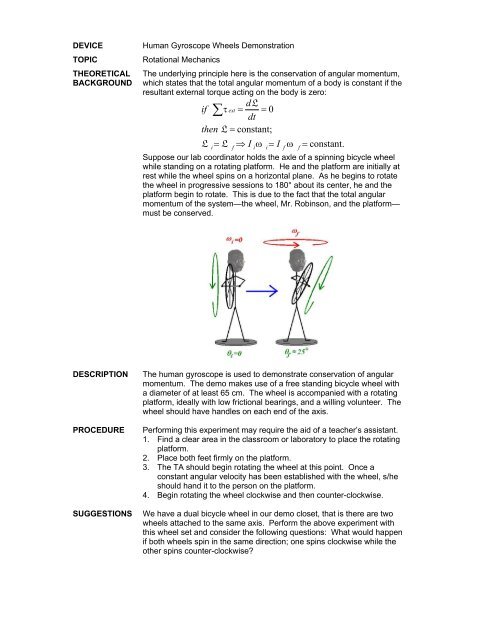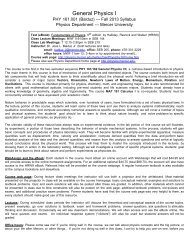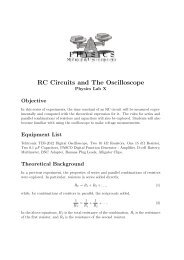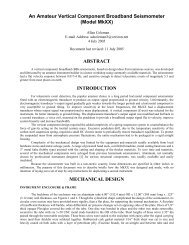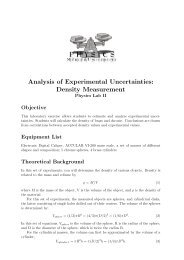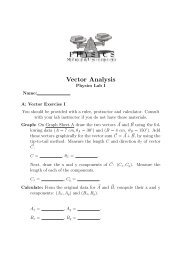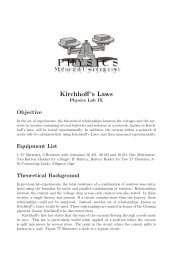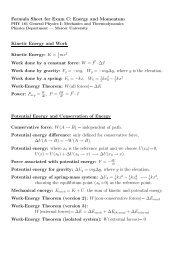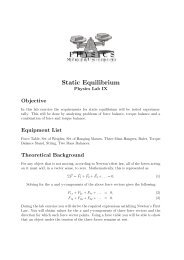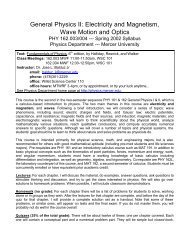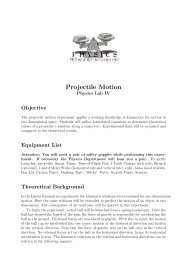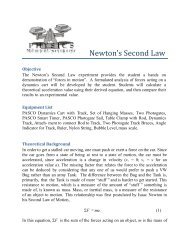0 constant; constant. d if dt then I I Ï Ï Ï = = = = â = = L L L L
0 constant; constant. d if dt then I I Ï Ï Ï = = = = â = = L L L L
0 constant; constant. d if dt then I I Ï Ï Ï = = = = â = = L L L L
- No tags were found...
You also want an ePaper? Increase the reach of your titles
YUMPU automatically turns print PDFs into web optimized ePapers that Google loves.
DEVICETOPICTHEORETICALBACKGROUNDHuman Gyroscope Wheels DemonstrationRotational MechanicsThe underlying principle here is the conservation of angular momentum,which states that the total angular momentum of a body is <strong>constant</strong> <strong>if</strong> theresultant external torque acting on the body is zero:dL<strong>if</strong> ∑τext = = 0<strong>dt</strong><strong>then</strong> L = <strong>constant</strong>;Li= Lf⇒ Iiωi= Ifωf=<strong>constant</strong>.Suppose our lab coordinator holds the axle of a spinning bicycle wheelwhile standing on a rotating platform. He and the platform are initially atrest while the wheel spins on a horizontal plane. As he begins to rotatethe wheel in progressive sessions to 180° about its center, he and theplatform begin to rotate. This is due to the fact that the total angularmomentum of the system—the wheel, Mr. Robinson, and the platform—must be conserved.DESCRIPTIONPROCEDURESUGGESTIONSThe human gyroscope is used to demonstrate conservation of angularmomentum. The demo makes use of a free standing bicycle wheel witha diameter of at least 65 cm. The wheel is accompanied with a rotatingplatform, ideally with low frictional bearings, and a willing volunteer. Thewheel should have handles on each end of the axis.Performing this experiment may require the aid of a teacher’s assistant.1. Find a clear area in the classroom or laboratory to place the rotatingplatform.2. Place both feet firmly on the platform.3. The TA should begin rotating the wheel at this point. Once a<strong>constant</strong> angular velocity has been established with the wheel, s/heshould hand it to the person on the platform.4. Begin rotating the wheel clockwise and <strong>then</strong> counter-clockwise.We have a dual bicycle wheel in our demo closet, that is there are twowheels attached to the same axis. Perform the above experiment withthis wheel set and consider the following questions: What would happen<strong>if</strong> both wheels spin in the same direction; one spins clockwise while theother spins counter-clockwise?
DEVICETOPICTHEORETICALBACKGROUNDMoment of Inertia Using CylindersRotational MechanicsThe moment of inertia of an object is a measure of how the mass of the rotating object isdistributed about its axis of rotation. A common definition for moment of inertia is that themeasured quantity of rotational inertia determines the resistance an object has to freerotation. If an object has all of its mass evenly distributed around its rotational axis, like thesolid disk, <strong>then</strong> its resistance to rotation is the same for all radial distances parallel to therotational axis. Consider the following equation:12Idisk= MdiskRdisk2where Idiskis the moment of inertia of the disk, Mdiskis the mass of the disk, and Rdiskisthe radius of the disk. For a hoop with a mass equal to the disk, the equation becomes2I = M Rhoop hoop hoopHere the mass of the hoop is not evenly distributed around the rotational axis. However, itsmass is located on the outer edge further away from the axis of rotation, causing the hoop torotate with a greater amount of resistance comparable to the solid disk.DESCRIPTIONPROCEDURESUGGESTIONSThe use of cylindrical objects effectively demonstrates the concept of rotational inertia forobjects of like masses, but d<strong>if</strong>fering mass orientations. The apparatus includes a solid diskand a ringed hoop, each weighing approximately the same. A flat wooden board propped bya wooden plank about 3 inches thick is used to make an incline.1. Construct an incline using flat board and a plank.2. Mass the disk and hoop.3. Predict whether or not the hoop will reach the bottom first.4. Choose one:4.1. EITHER release the disk and hoop at the same time measuring the time each takesto reach the bottom with a stopwatch;4.2. OR using a stopwatch release first the disk and <strong>then</strong> the hoop.5. Compare the time each took to reach the bottom and re-evaluate your prediction.


